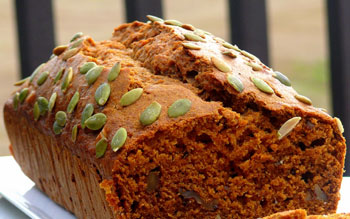 Who thought reduced calorie pumpkin bread could be so good? Well, I'm hear to tell you it is. Aren't you lucky? Anyway, my bestie's mama, Sharon (Hi Sharon!) tweaked up a recipe and came up with this little gem (I tweaked it a tad bit more as well). Anyway, it's moist, it's pumpkin-ee and a perfect fix with coffee.
Who thought reduced calorie pumpkin bread could be so good? Well, I'm hear to tell you it is. Aren't you lucky? Anyway, my bestie's mama, Sharon (Hi Sharon!) tweaked up a recipe and came up with this little gem (I tweaked it a tad bit more as well). Anyway, it's moist, it's pumpkin-ee and a perfect fix with coffee.
So here's the thing, I was looking at nutritional information for regular, full-calorie pumpkin bread and it averages about 179 calories per slice. Now, they consider one slice to be 1 ounce in terms of weight. I can tell you right now that no one ever cuts a 1 ounce slice of pumpkin bread and considers that a serving. It's minuscule and definitely wouldn't hold a slab of butter. This means that a regular slice, one that you would just normally cut and looks like "normal size" weighs about 2.4 ounces (based on a 12 serving loaf made in an 8 x 4 pan). So one slice of regular pumpkin bread is about 429 calories. OUCH!
So this lovely recipe will cut your calories in half, coming in at only 228 calories per 2.4 ounce slice. That's a huge savings. Now, since you are saving so many calories, you can slather on the butter..he-he. Or cream cheese, or...or...
Fall
Fall
Yams vs. Sweet Potatoes
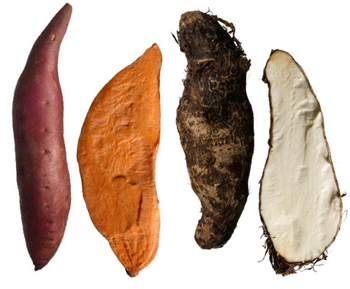 What is the difference between a sweet potato and a yam?
What is the difference between a sweet potato and a yam?
And here's the answer, according to the Library of Congress:
Although yams and sweet potatoes are both angiosperms (flowering plants), they are not related botanically. Yams are a monocot (a plant having one embryonic seed leaf) and from the Dioscoreaceae or Yam family. Sweet Potatoes, often called ‘yams’, are a dicot (a plant having two embryonic seed leaves) and are from the Convolvulacea or morning glory family.
Food Blogga Translation: Yams and sweet potatoes are different vegetables.
It turns out my local market has gotten it wrong too. What they have been labeling as yams are really red-skinned, orange-fleshed sweet potatoes. Apparently, sweet potatoes' skin and flesh ranges in colors, and they come in "hard" and "soft" varieties. It is the soft varieties, which become moist when cooked, that are typically labeled "yams" here in the United States.
Apple Tarte Tatin
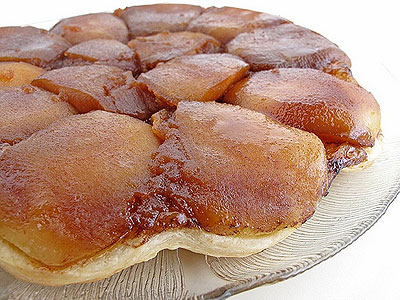 There are plenty of reasons to enjoy apples this season. For me it's because they make the best desserts. With apples so plentiful at farmers' markets and supermarkets this time of year, I love to make tarts. There's just something special about an apple tart particularly apple tarte Tatin, one of the most classic of the French tarts. It's a dessert that can be called both comforting and elegant. Supposedly, as the story goes, the Tatin sisters invented the dessert by accident while attempting to make an apple tart to serve their hotel guests. The dish became so popular that its fame spread throughout the Sologne region. It's now known throughout the world. It seems that the best things are almost always invented accidentally.
There are plenty of reasons to enjoy apples this season. For me it's because they make the best desserts. With apples so plentiful at farmers' markets and supermarkets this time of year, I love to make tarts. There's just something special about an apple tart particularly apple tarte Tatin, one of the most classic of the French tarts. It's a dessert that can be called both comforting and elegant. Supposedly, as the story goes, the Tatin sisters invented the dessert by accident while attempting to make an apple tart to serve their hotel guests. The dish became so popular that its fame spread throughout the Sologne region. It's now known throughout the world. It seems that the best things are almost always invented accidentally.
Traditionally tarte Tatin starts out by melting butter in a skillet and adding sugar to make a caramel. Then apple quarters are added and cooked until tender. A round of pastry dough tops the apples and the whole skillet is placed in the oven. In my adaptation, I use brown sugar for its fullness of flavor, and add a pinch of cinnamon and a dash of brandy for that extra bit of goodness. Instead of cooking the apples in the caramel, which either tends to overcook them or burn the caramel, I just place the apples in the pan, cover with pastry, and bake. Serve a slice warm with a dollop of crème fraîche or a scoop of vanilla ice cream and it's the perfect dessert after a cozy dinner or any time when the caving hits.
Roasted Brussels Sprouts with Preserved Lemon
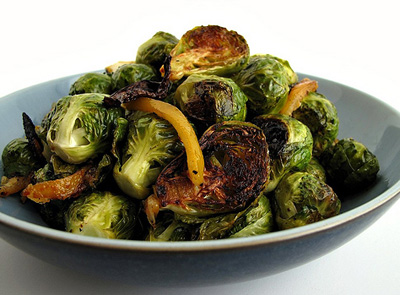 Fall produce isn't just about pumpkins and squash, which is what most people assume. Other vegetables, too, reach their prime in the fall. Right now you'll find a host of cabbages in season, including the entire family—cauliflower, broccoli, and Brussels sprouts, which are my personal favorite. These mini cabbages are so adorable—I just wish more people liked them.
Fall produce isn't just about pumpkins and squash, which is what most people assume. Other vegetables, too, reach their prime in the fall. Right now you'll find a host of cabbages in season, including the entire family—cauliflower, broccoli, and Brussels sprouts, which are my personal favorite. These mini cabbages are so adorable—I just wish more people liked them.
When it comes down to it, you either know how to cook Brussels sprouts or you don't. Those that don't know how to cook them ruin it for everyone else. A pot of over-boiled sprouts never could make anyone like the vegetable (kids liken the smell to stinky feet). The correct cooking method is key to coaxing out the natural sweet flavor of sprouts. No other method can do that better than roasting.
The simplest way to prepare sprouts for roasting is to toss them with oil, salt, and pepper. Then just roast until tender, about 25 minutes. You can customize the basic recipe to suit your own tastes, e.g. add some herbs or vinegar or even lemon juice. For this recipe I utilize preserved lemons I made earlier in the year. Thin slices of the lemon rind along with some of the briny juice give this dish a noteworthy zip. You will love sprouts prepared this way.
Skillet Boneless Pork Chops with Rosemary Peaches
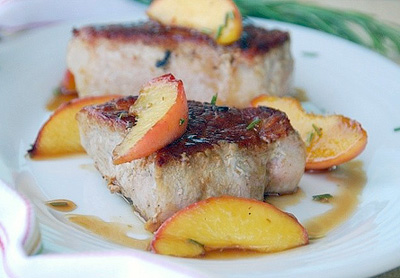 I have always associated peaches with July and August. That is until a few years ago when I discovered the most succulent peaches I ever tasted -- in September.
I have always associated peaches with July and August. That is until a few years ago when I discovered the most succulent peaches I ever tasted -- in September.
Peach season in California is long and abundant; it runs from May to October and peaks from July through September. In general, peaches are picked early to withstand shipping and to have a longer shelf life. The problem is when you take home many of these peaches, they are as hard as a rock (and taste like one too). That's why buying locally grown peaches is a better option when possible.
A couple of years ago at a local farmers' market I discovered Summerset peaches, which peak in September. Like a California sunset, these fruits are a dazzling blend brilliant reds, warm oranges, and golden yellows. In addition to being visually beautiful, they emit a delicate floral aroma and are amazingly juicy and succulent, as if warmed by the sun.
More Articles ...
Welcome to the new One for the Table ...
Our Home Page will be different each time you arrive.
We're sure you'll find something to pique your interest...

